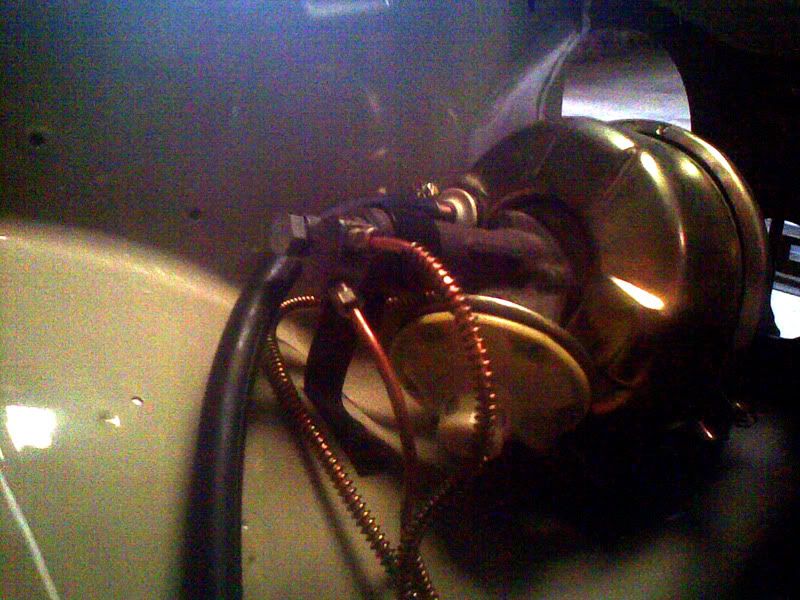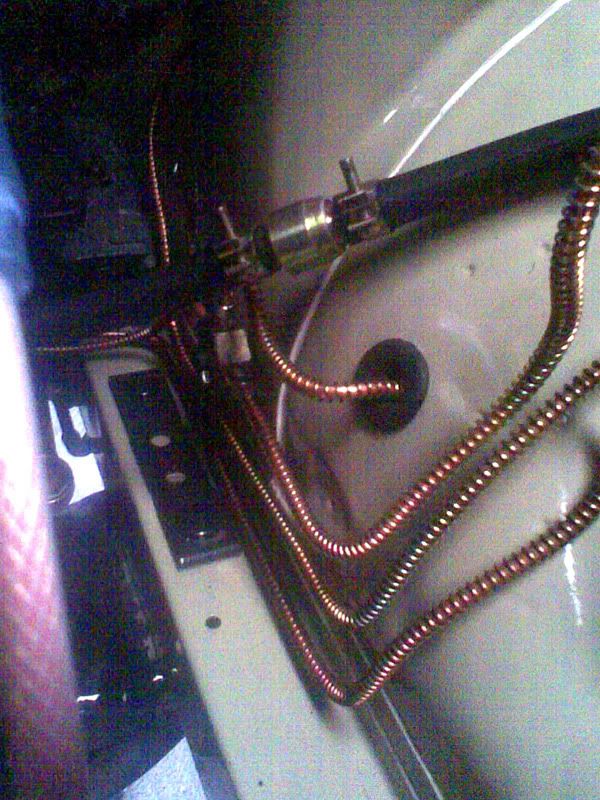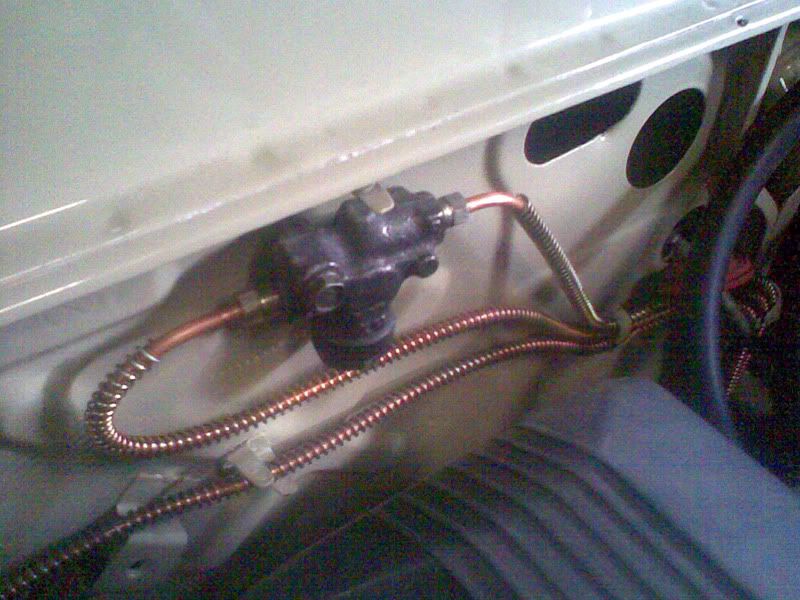Part 7: Oil Coolers and Stuff
A quick note before I begin. I'm not really doing these parts in any particular order. I just write them down as the ideas for the blog entries pop into my head. That said, let's skip ahead to something I just finished working on; the oil cooler.
To better appreciate this upgrade we should first look at what the oil does in the engine. On the face of it, most people see oil as just the stuff that lubricates the engines moving parts. However oil also functions to cool about half the engine and acts as a detergent keeping the engine internals free from dirt. Half the battle in keeping the engine cool is the oil. The engines main cooling system- the radiator for the engine's coolant, only cools about half of the whole assembly; from the cylinder head to around the part where the water pump is mounted which is usually about half way. The rest of the engine block down to the crank case and oil pan is cooled by the oil alone. Most high performance engine setups will upgrade the radiator and it's related accessories to improve cooling but to be able to sustain this cooling performance the oil side has to be addressed also.
Most resources I have found online while doing research on the subject suggest that oil is good up to about 200 deg. Fahrenheit. Above this temperature the oil starts to break down and so does it's lubricating properties. This is true for most oils anywhere from mineral to synthetic. For the oil to be able to best perform it's job it has to be maintained within a certain temperature range; hot enough to move freely through the engine, yet cool enough to lubricate well and cool the rest of the engine. This is where the oil cooler comes in. It is basically a secondary radiator for the engine oil that allows the oil temperature to be maintained at around 180 deg. Fahrenheit or so. The oil cooler additionally adds more oil capacity to the system. About 1 liter more. The more oil going around the system means that there will be more capacity to handle the heat.
Oil and water temperature are independent. The radiator will maintain the coolant temperature at a constant level no matter how hard you drive, but the oil temperature will climb until the oil overheats. For those who race, this is said to be after something as short as 3 to 4 laps of a track. Coolant temperature will still be ok, but the engine will start to lose power as the oil heats up beyond the point where it is efficient. An oil cooler will allow lap after lap of constant oil temperature since like the coolant radiator it will maintain the oil at a constant temperature as well. This also applies to us none racers who like tuning our cars. Fitting an oil cooler can have you happily running up and down the high way and all over your fave mountain pass all day without the engine breaking out a sweat.
Even though both my tuning mentors have suggested I do this fit an oil cooler to my project for quite some time. It was only last week that I finally got around to completing the '79 Lancer's oil cooler system (even though I have had most of the parts necessary for a little over a year) and knowing what I know now, I actually feel pretty bad for not giving my engine this sooner. A quick drive over the weekend showed how much 'happier' the engine was with it's new cooler oil. The oil cooler we used is a modified unit originally fitted to either a Mitsu Galant VR-4 or an early Lancer Evo with the fittings modified for the '79. This oil cooler is equipped with a thermostat that by passes the cooling core while the oil is still cold and closes to start cooling the oil once it has reached it's predetermined ideal oil temperature (the exact value of which I really don't know). It was interesting to note though that after a 20 min. chill drive from my house, just enough to get the coolant up to operating temperature, the cooling core was warm to touch. Meaning that the oil had already reached it's ideal operating temperature and had to be sent through the cooling already to prevent it from going up any more. I wish I had fitted an oil temp gauge to give actual figures for this but it's easy to imagine what the oil would go through if you were really going for it.
Much like the story with the MSD, the oil cooler is really something I should have done much sooner. In the same way it is also something you don't look for until you've experienced it then it becomes something you think is indispensable. If you're even half serious about tuning or racing and you don't have one yet- for the love of your engine get one now.
The following details the oil cooler setup for the '79 Lancer.
The oil cooler it's self is a unit designed for the Mitsubishi 4G63T. Most factory turbo engine are equipped with one, naturally aspirated ones on the other hand rarely ever have one. The cooler was oriented in such a way that gravity would help the oil flow down through the cooling core with the input tank on top and the output tank at the bottom. This is not how it is positioned in the factory setup- but this is better. The oil cooler was also mounted in front of the radiator to give it first dibs on the cool incoming air. There is also a powerful fan mounted directly behind the oil cooler and radiator to pull air through both. Mount this in a carefully chosen location where it will be well protected. It's not hard to damage the aluminum core and a leaking oil cooler will stop you dead in your tracks. As cool as those externally mounted oil coolers of the Skyline Hakosuka looks (often imitated in non-functional form by Bozozoku cars- Google is your friend if you don't know what I'm talking about.) a well chosen safe location is smarter.
A lot of custom fabrication was required to convert the 4G63T oil cooler to work with the '79 Lancer's modified 4G33. This included making custom fittings for the cooler core itself. Custom fabricated brackets are also used all around to hold these parts in place.
To bring the oil from the engine to the oil cooler I used an oil filter relocation kit. This uses a block adaptor in place of the stock oil filter to have input and out put lines from the engine to the oil cooler.
Note that the fittings are pressed not clamped. I have heard stories of guys who use ordinary hose clamps on these fitting and have had one of the lines pop off while running. Potentially a dangerous and disastrous situation.
The oil filter is then remotely mounted in between the engine and the oil cooler. This can be place anywhere really but my mentors advised that a good rule of thumb is still to have it about the same level as the original filter location to avoid putting unnecessary stress on the oil pump.
An alternative to this setup is a simpler oil filter sandwich plate setup which out the in and out fittings right before the oil filter in the stock location. This is simpler but depending on the application there might not be enough space for the oil filter to be moved forward a good amount.
Connecting everything together are 3 custom made high pressure oil lines. (would be 2 in the case of an oil filter sandwich plate application.) Engine out to oil cooler in. Oil cooler out to oil filter in. Oil filter out to engine in. The oil filter should always be last. Cleaning the oil before sending it back in. In total the oil lines of my setup run to almost 9 feet in length. My good friend and mentor who runs a sandwich plate says his setup goes to about 8 feet for the two oil lines. This is ok though as the length of the lines acts as an additional head sink and this is nothing a healthy oil pump cannot handle.
Once you've added an oil cooler be sure to increase the oil pressure to compensate for it.






















